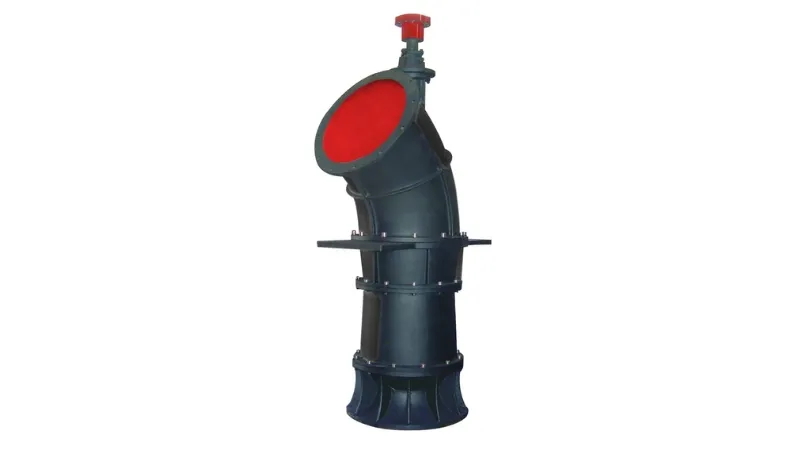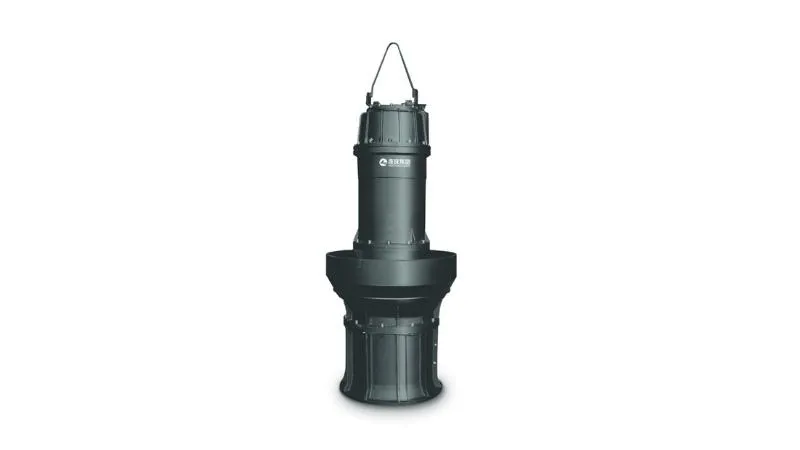


1. What is an axial flow pump?
2. Working principle of axial flow pump
3. Application field of axial flow pump
4. Features and advantages of axial flow pump
5. Classification of axial flow pumps
5.1 Single-stage axial flow pump and multi-stage axial flow pump
5.2 Flat axial flow pump and vertical axial flow pump
6. Development trend and innovation of axial flow pump
6.1 Application of new materials
6.2 Intelligent control and monitoring technology
6.3 Requirements for energy saving and environmental protection
7. Difference between axial flow pump and radial centrifugal pump
Axial flow pump is a common type of pump, which has attracted much attention for its high flow and low head. It plays an important role in many fields, from hydraulics to drainage systems to cooling systems and irrigation systems. This article will give you an in-depth understanding of the working principle, characteristics and application considerations of axial flow pumps.
An axial flow pump is a type of pump used to transport liquids or gases. It pushes the fluid along the axial direction through the rotating impeller, so as to realize the delivery of high flow and low lift. Axial flow pumps are suitable for applications requiring high flow rates, such as hydraulic engineering, drainage systems, cooling systems and irrigation systems, etc. It has a simple design structure, high efficiency and reliability, and is widely used in various industries.
Axial flow pumps are typically used in applications that require high flow rates and relatively low heads, such as hydroelectric power stations, drainage systems, cooling systems, and irrigation systems. They can handle large volumes of liquid or gas and are suitable for tasks such as liquid transfer, dredging, sewage discharge and flood control. Axial flow pumps can be designed in different sizes and powers according to specific needs to meet the requirements of specific applications.
The basic structure and components of an axial flow pump include the pump casing, impeller, pump shaft, bearings, inlet and outlet ports and guide rings/guide vanes. The pump casing is used as an external structure to fix and support other components, and the impeller generates centrifugal force through rotation to push the fluid to move along the axis. The pump shaft connects the impeller and the motor to transmit the rotational power. Bearings support the pump shaft and reduce friction.
The principle of fluid mechanics is the basis of the working principle of the axial flow pump. These include Newton's second law, the law of conservation of mass, the law of conservation of momentum, and Bernoulli's equation. According to these principles, a force is applied to the fluid by the rotating impeller in the axial flow pump, so that the fluid acquires momentum and accelerates in the direction of the axis. At the same time, the law of conservation of mass ensures that the mass of the fluid remains constant within the pump, while the law of conservation of momentum keeps the total momentum of the fluid constant.
The working process of the axial flow pump can be summarized as the following steps: the fluid enters the pump body through the inlet port, the impeller starts to rotate, the fluid is pushed forward by the impeller and accelerates, resulting in a decrease in pressure, and finally the fluid is discharged from the pump body through the outlet port. This process is achieved by the centrifugal force generated by the rotation of the impeller, which pushes the fluid forward and in the direction of the axis. Axial flow pumps are designed to provide high flow and low head delivery capabilities. However, pump efficiency and performance are affected by several factors, so specific needs and operating conditions need to be considered when selecting and applying an axial flow pump.
Axial flow pumps are widely used in hydraulic engineering projects such as hydropower stations, dams and reservoirs. They are used to move large volumes of water to drive turbines to generate electricity or to regulate water levels.
Axial flow pumps are used in urban drainage systems, sewage treatment plants and flood control systems to remove large volumes of sewage or stormwater from low-lying areas or buildings.
In industrial and power equipment, axial flow pumps are used in cooling systems to deliver a cooling medium such as water or air to the equipment to maintain its normal operating temperature.
In the field of agriculture, axial flow pumps are used in large-area irrigation systems to transport water from water sources to farmland to ensure that plants receive sufficient water supply.
Axial flow pumps are often used in ships and port facilities, such as ship propulsion systems, pump room drainage and port water maintenance.
In the chemical and petroleum industries, axial flow pumps are used to transport various chemical liquids and petroleum products, such as raw material liquids, fluids and oil products in refining processes.
Axial flow pumps are also used in hydrological research and laboratory testing to simulate and study the behavior and characteristics of water flow.
It is capable of delivering large volumes of fluid at high rates, but has a relatively low vertical lift for the fluid. This makes axial flow pumps ideal for applications that require large volumes of fluid transfer and do not require high heads, such as hydraulics, drainage and irrigation systems.
Axial flow pumps are characterized by high efficiency. The key factors to achieve high efficiency of axial flow pumps include optimized impeller design, flow path design, proper material selection and proper operating parameters. By considering these factors, axial flow pumps can achieve high efficiency in energy conversion, improve energy utilization, reduce energy consumption and operating costs, and reduce environmental impact. Therefore, high efficiency is an important consideration when selecting and using an axial flow pump.
Axial flow pumps are suitable for large water pump systems and can meet the requirements of large flow, low head, high efficiency and adjustability. Therefore, in the design and application of large water pump systems, axial flow pumps are one of the common and important choices.
Single-stage axial flow pump and multi-stage axial flow pump
Single-stage axial flow pumps are suitable for applications requiring high flow rates with low heads, while multi-stage axial flow pumps are suitable for applications requiring higher heads. Selecting the right axial flow pump type depends on specific fluid transfer needs, engineering parameters, and system requirements.
Flat axial flow pump and vertical axial flow pump
Plane axial flow pumps are suitable for horizontal flow applications, while vertical axial flow pumps are suitable for vertical flow applications. Therefore, when selecting the pump type, it is necessary to consider the direction of liquid flow, installation space and other engineering parameters to ensure that the appropriate pump type is selected.
New materials are widely used in various fields, including carbon fiber composites, titanium alloys, high-performance polymers, superalloys, optical glass and nanomaterials. These new materials have unique properties and characteristics that can provide high strength, light weight, corrosion resistance, high temperature resistance, excellent optical properties, and more. They play an important role in various fields such as aerospace, automotive industry, energy field, medical devices, electronics and so on. The application of new materials has promoted technological progress and improved product performance, bringing more opportunities for innovation and development to all walks of life.
Intelligent control and monitoring technology refers to the technology that realizes intelligent monitoring, diagnosis and control of equipment, systems or processes by integrating sensors, data acquisition, analysis algorithms and automatic control systems. These technologies can increase productivity, reduce energy consumption, optimize resource utilization, and provide real-time data and decision support.
Energy saving and environmental protection requirements
The requirement of energy conservation and environmental protection is an inevitable trend in the development of modern society. It can not only help reduce energy costs and environmental pollution, but also promote sustainable development and enhance corporate competitiveness. By adopting advanced technology and management methods, we can achieve the goals of energy saving and environmental protection in various fields, and create a more sustainable and livable environment for our future.
| Parameter | Radial Flow Pump | Axial Flow Pump |
|---|---|---|
| Flow Direction | Radial | Axial |
| Efficiency | Medium to high | High |
| Pressure Range | High pressure | Low pressure |
| Operating Range | Low to high flow rate | High flow rate |
| Cost | Low cost | High cost |
| Impeller Type | Curved blades | Propeller-like |
| Size | Small to large | Large |
| NPSH | More required | Less required |
| Cavitation | More likely | Less likely |
| Applications | Oil and gas, water supply, chemical processing, and HVAC | Hydroelectric, marine, cooling, flood control, and irrigation |
Brand reputation and history: Choose a manufacturer with a strong brand reputation and long history. These manufacturers usually have extensive experience and expertise and are known for the quality and reliability of their products.
Technical Capabilities and R&D Capabilities: Learn about manufacturers' technical capabilities and R&D capabilities. Excellent manufacturers usually have advanced technology and innovation capabilities, can provide high-performance, high-efficiency axial flow pumps, and continuously improve products to meet changing needs.
Quality management system: Ensure that the manufacturer has an effective quality management system, such as ISO 9001 certification. This shows that manufacturers follow strict standards and processes in product design, manufacturing and quality control to ensure product consistency and reliability.
Production Capabilities and Facilities: Assess the manufacturer's production capabilities and facilities. Find out if they have advanced production equipment and processes to ensure that they can deliver high-quality products on time.
Service support and after-sales service: Learn about the manufacturer's service support and after-sales service. Make sure they can provide timely and responsive technical support, repair and spare parts supply to ensure that the axial flow pump can be effectively supported and maintained during use.
References and evaluations: Gather as much reference and evaluation information as possible on manufacturers. Talk to other users, engineers or professionals about their experiences and opinions about the manufacturer to gain a more complete understaning.
Cost-effectiveness: Finally, considering the balance between price and performance, choose a manufacturer with reasonable price and good performance.
As an important liquid conveying equipment, axial flow pump plays a key role in various fields, providing convenience and benefits for people's life and industrial production. If you need axial flow pump, welcome to contact us!
.png)

